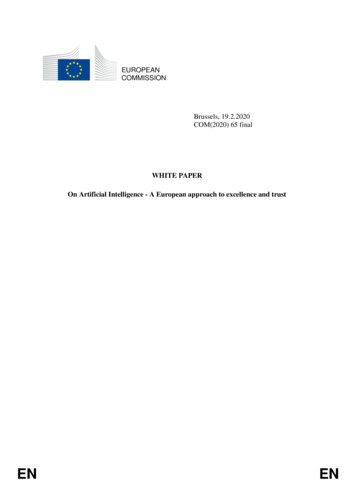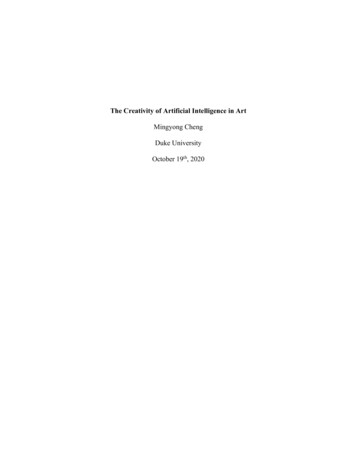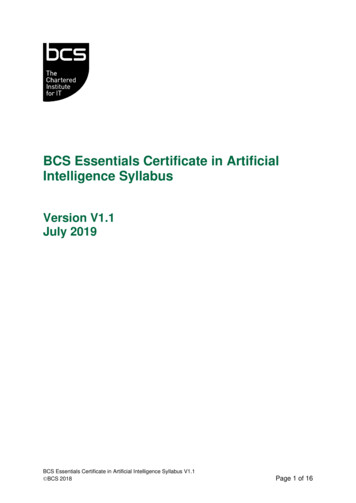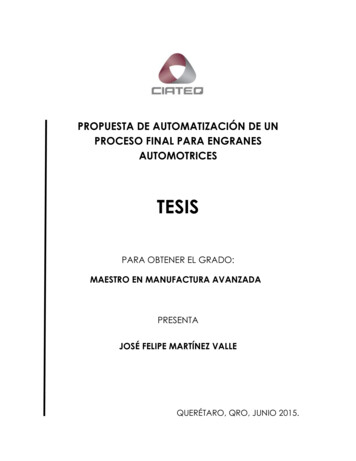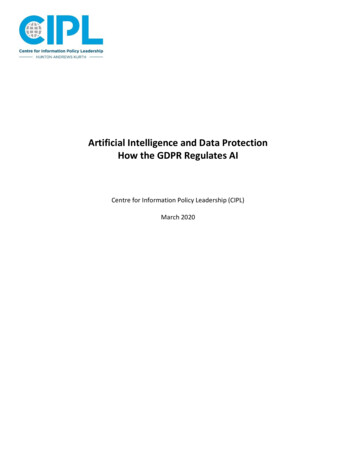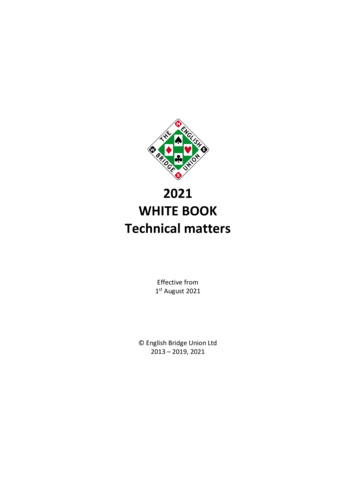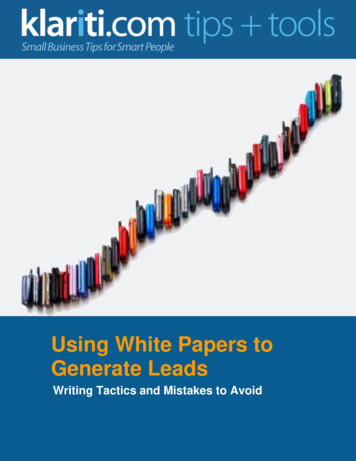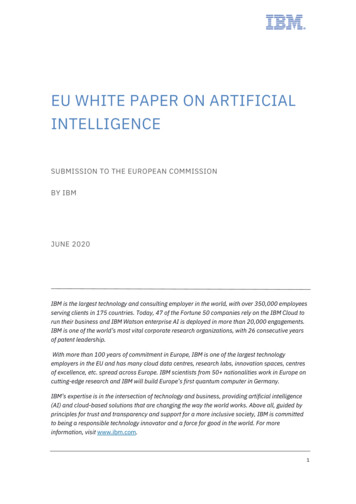
Transcription
EU WHITE PAPER ON ARTIFICIALINTELLIGENCESUBMISSION TO THE EUROPEAN COMMISSIONBY IBMJUNE 2020IBM is the largest technology and consulting employer in the world, with over 350,000 employeesserving clients in 175 countries. Today, 47 of the Fortune 50 companies rely on the IBM Cloud torun their business and IBM Watson enterprise AI is deployed in more than 20,000 engagements.IBM is one of the world’s most vital corporate research organizations, with 26 consecutive yearsof patent leadership.With more than 100 years of commitment in Europe, IBM is one of the largest technologyemployers in the EU and has many cloud data centres, research labs, innovation spaces, centresof excellence, etc. spread across Europe. IBM scientists from 50 nationalities work in Europe oncutting-edge research and IBM will build Europe’s first quantum computer in Germany.IBM’s expertise is in the intersection of technology and business, providing artificial intelligence(AI) and cloud-based solutions that are changing the way the world works. Above all, guided byprinciples for trust and transparency and support for a more inclusive society, IBM is committedto being a responsible technology innovator and a force for good in the world. For moreinformation, visit www.ibm.com.1
INTRODUCTIONIBM welcomes the opportunity to contribute to the European Commission’s consultation ontheir February 2020 White Paper on Artificial Intelligence, and to offer our views on themeasures we believe can help ensure responsible development and deployment of AI systems.It is rare that a technology attracts the level of attention that AI has from policy-makers,business, academics, media and the public, especially at a relatively early stage in its adoption.That it has done so reflects both the enormous positive potential that all stakeholders recognizein AI, as well as the many concerns – some well-founded, others perhaps less so.The European Commission has been to the forefront of global efforts to understand and assessthe risks and the benefits that AI offers, and to set out a public policy framework that balancesthe management of those risks with promoting the innovation and uptake necessary for thebenefits to be realized. We welcomed the ethical principles developed by the Commission’sHigh-Level Expert Group on AI last year, as well as the OECD’s AI Principles, and we continue tobe active participants in multistakeholder dialogues seeking to address the issues surroundingtrustworthy AI.Principles are important to help communicate a government’s or a company’s commitments tocitizens and consumers, and to set a direction in a complex and evolving area. However, it is nowtime to move from principles to clear policies that all stakeholders can rely on. For that reason,we welcome the Commission’s AI White Paper and this consultation process as an importantstep towards operationalizing the high-level principles already established.2
RESPONSE TO THE EUROPEAN COMMISSION’S WHITE PAPER ON AIThe White Paper correctly emphasizes the paramount importance of trust, both for companiesbuilding and deploying AI, and anyone making use of this technology. IBM has been a vocalsupporter of responsible data stewardship and privacy protection for many years, and thisstrongly informs our approach to AI. Our Trust and Transparency Principles1 describe ourcommitment to the belief that1. The purpose of AI is to augment – not replace – human intelligence.2. Data and insights belong to their creator.3. New technology, including AI systems, must be transparent and explainable.On the basis of these principles, IBM supports targeted policies that would increase theresponsibilities for companies to develop and operate trustworthy AI. As the White Paperrecognizes, an effective governance framework must first of all be risk-based, and it must seekto regulate not the technology itself but rather its uses. We strongly agree with this overallapproach, and believe it is consistent with what we set out in our January 2020 policy paper onAI regulation2, where we proposed that a risk-based governance framework for AI should bebased on the pillars of accountability, transparency, fairness and security.In the sections below we provide comments on the contents of the White Paper, following itssection numbering. Our main points in relation to the proposed regulatory framework for AI are: For regulatory purposes the definition of AI systems needs to be narrow and clear, sothat the focus is on those systems that cause serious concern and avoiding non-AIsystems being inadvertently included.There should be a single risk assessment framework to identify high-risk applicationsregardless of sector, and without lists of exceptions.In sectors where established conformity assessment mechanisms already exist, theseshould also cover high-risk AI applications in those sectors. In other sectors, anappropriate level of compliance for high-risk applications can be achieved with acombination of ex-ante self-assessment and ex-post auditing and enforcement.While voluntary labelling systems can be helpful to consumers or end-users in somemarkets, we do not believe they would be effective across such a broad field as AIapplications.“IBM’s Principles for Trust and Transparency,” THINKPolicy, 30 May 2018, available s/.12“Precision Regulation for Artificial Intelligence,” IBM Policy Lab, 21 Jan. 2020, Ryan Hagemann and Jean-Marc ion-regulation/.3
4. AN ECOSYSTEM OF EXCELLENCEIn contrast with some of the negative commentary around Europe’s global standing in AI, wesee a Europe that is well-placed both to take advantage of widespread AI adoption, and tocontribute strongly to the development of the underlying science and technologies. Theapproach set out in the “Ecosystem of Excellence” section of the White Paper will help to furtherstrengthen that position and help to build the capacities needed to drive successful adoptionand further development of AI in Europe, including through promoting research and innovation,developing skills, coordinating national policies and initiatives, encouraging adoption by thepublic sector, and building strong public-private partnerships.In particular, we support the emphasis on skills, where AI needs to be reflected appropriatelythroughout all levels of the formal education system, including in vocational training andapprenticeships, as well as in targeted re-skilling and lifelong learning initiatives. In addition tothe long-standing emphasis on Science, Technology, Engineering and Mathematics (STEM) skillsand competences, it is important to recognize that arts and creative disciplines are alsonecessary for a vibrant AI ecosystem. There is also significant potential for AI to driveimprovements in the delivery of education across all domains.Public/private partnerships can be valuable tools for encouraging strong private sectorinvolvement in developing an ecosystem of excellence and ensuring a broad-based andcoherent approach. However, to be effective, partnership models should remain open toparticipation by any company that can provide relevant capabilities and that complies withEuropean regulations and values, even if they are headquartered outside the EU.The potential for AI to significantly improve the delivery of public services for the EU’s citizens issignificant, despite the particular challenges that many public services face in adopting AI. TheCommission is right to focus on actions to address this, including developing technicalcapabilities within public bodies and agencies, ensuring public servants are familiar with AI’simplications, and that anyone using AI systems in the public service is appropriately trained.As the European Data Strategy identifies, there is enormous potential in public sector data toimprove the lives of EU citizens. Unlocking that value should be a key focus, including throughmaking non-sensitive public sector data available for research, and by establishing rules aroundpermitted usage of public sector data by private enterprise.4
5. AN ECOSYSTEM OF TRUST: REGULATORY FRAMEWORK FOR AIWe agree with the need for a consistent EU-wide regulatory framework for trustworthy AI, andthat this would help give businesses and consumers alike the confidence to develop and adoptAI-based solutions.Any successful governance framework for AI will need to account for the many and variedapplications of AI both in use today and likely to be used in the future. The best means ofstriking an appropriate balance between effective rules that protect the public interest and theneed to promote ongoing innovation and experimentation is with a precision regulationapproach that creates expectations of accountability, transparency, fairness and securityaccording to the role of the organization (whether a provider, owner, or some mix of both) andthe risk associated with each use-case of AI.5A. PROBLEM DEFINITIONThe White Paper focuses on the challenges that AI poses for the application of rules protectingfundamental rights, and addressing safety and liability, noting that “opacity (‘black box-effect’),complexity, unpredictability and partially autonomous behaviour” create challenges forverification of compliance and effective enforcement of existing EU law meant to protectfundamental rights. However, it is also true that human beings using AI (or not) and governed byexisting bodies of law pose similar challenges.In that light, we suggest that the degree to which autonomy and the judgment of a human actorare ceded to an AI system should be a key factor in determining the degree to which AI posesnew problems to be addressed by new regulation. Where a person receives the output of an AIsystem as one factor in making a decision for which that person retains responsibility, whilebeing given sufficient information about the training and functioning of that system to makereasonable judgements about its utility, current laws should suffice. Where, however, humanautonomy or judgment are substantially ceded to an AI system, whether by choice (for example,automatic reviews of loan applications) or by the nature of the activity (for example,autonomous driving), then the problem at hand might be fairly characterized as new and unique.5B. POSSIBLE ADJUSTMENTS TO EXISTING EU LEGISLATIVE FRAMEWORKRELATING TO AIEven though much of it was written without having digital technologies explicitly in mind, theEU’s existing legal framework already applies to AI applications, including for example,fundamental rights protections, the General Data Protection Regulation (GDPR), product safety,and consumer protection regulations. The General Product Safety Directive (GPSD) has a proventrack-record as a ‘safety net’ complementing sector-specific regulations. In particular, thetechnology-neutral approach to formulating requirements for safe products has proven to be5
effective with new challenges like interconnectivity, cyber threats, human-machine-interaction,AI, etc.3Effective application and enforcement of existing legislationIt is true that in some cases there is a lack of clarity about exactly how these existingframeworks would apply or be enforced in the context of AI solutions, so there is a need forassessment and for clarification or guidelines, particularly for high-risk use cases. However,new legislation should only be considered for specific high-risk cases where it is determined thatexisting frameworks cannot be adequately applied, clarified or adapted. Any new legislativeproposals on AI, or in related areas (such as the draft e-Privacy Regulation), should beconsistent with existing legal frameworks to avoid diverging rules and legal uncertainty, whichcould have a negative effect on innovation and the uptake of AI within the EU. They should alsoclearly specify what additional risks any new legislation is seeking to address.Changing functionality of AI systemsThe White Paper notes that software updates during the operational lifetime of an AI systemcould change its functionality, and potentially its risk profile. (Note that the use of machinelearning does not necessarily imply that a system continues to learn, or evolve its operation,during its operational lifetime. In many cases an AI model remains static once deployed, unlesschanged by a subsequent software update.)However, the existing legal framework already addresses this issue, and we do not believechanges are required to address AI. Under the existing framework, if a product is changedsignificantly once placed on the market, the manufacturer must undertake a new riskassessment. This could be triggered by a modification of the intended use or reasonablyforeseeable use of the product, a change in the nature of a hazard or an increase of the level ofrisk. This is a well-established and accepted practice, with for example the Blue Guide stating inchapter 2.1: "A product which has been subject to important changes or overhauls aiming tomodify its original performance, purpose or type may be considered as a new product. The personwho carries out the changes becomes then the manufacturer with the corresponding obligations."For example, this recent RAPEX notification published on the EU Safety Gate’s website shows that market surveillanceauthorities were able to take legal action under the GPSD in relation to cybersecurity shortcomings in a smartwatch ers safety/safety products/rapex/alerts/?event viewProduct&reference A12/0157/19&lng en6
This concept fits appropriately in a world of software-enabled products where a software updatecan apply important changes to the product. Note that software updates often consist of purelybug fixes, in which case there should be no obligation to undertake a re-assessment.Allocation of responsibilities between different economic operatorsThe use of AI systems, and therefore any resulting liability, is context-specific: the focus of riskshould lie on a specific application and the context of its use. There is often a complex chain ofvarious producers and intermediaries involved - for example, the various technology producers(of data, software, hardware components, or physical products with embedded software), thesystems integrators (who train the AI system) and the owner/operator who is using the system.This is why a future-proof regulatory framework should ensure allocation of liability to the actorwho is closest to the risk, instead of introducing joint liability, as it would not make sense foranyone involved in making an AI system to be liable for problems they had no awareness of orinfluence over.In a business-to-business context, parties can negotiate for an efficient allocation of risk whichtakes account of each specific context and use. Contractual liability is working well and shouldtherefore be maintained. Any changes to the liability framework should be consistent with thescope of the Product Liability Directive.We disagree with the idea of expanding the definition of “product” in the Product LiabilityDirective to include software. It is difficult to envisage how standalone software could result inproperty damage, bodily injury or death. Generally speaking, services will still require a physicalinfrastructure in their execution, therefore physical products remain the basis for the guidanceand the application of the Directive. In most cases the relationship between provider and enduser is already covered by a contractual relationship, while services that are inherentlydangerous or pose specific risks to the users are usually already regulated and subject toinsurance (e.g. healthcare or legal services).7
5C. SCOPE OF A FUTURE EU REGULATORY FRAMEWORKWe strongly agree with the Commission’s view expressed in the White Paper that “the definitionof AI will need to be sufficiently flexible to accommodate technical progress while being preciseenough to provide the necessary legal certainty”. Much work has been done, for example, by theEU High Level Expert Group and by ISO/IEC SC42 on defining AI and related terms for ethicaland technical purposes, but for the regulatory context we suggest that an extension of theapproach taken by the OECD might be suitable, for example:An AI system can be broadly defined as one that makes predictions, recommendations ordecisions, influencing physical or virtual environments, and whose outputs or behavioursare not necessarily pre-determined by its developer. AI systems are typically trained withlarge quantities of structured or unstructured data, and may be designed to operate withvarying levels of autonomy or none, to achieve human-defined objectives. (“Autonomy”means acting, physically or virtually, without human intervention or oversight.)This definition is intended to focus on the features most likely to distinguish AI from non-AIsystems. However, given the dynamic nature of the field, it is not possible to come up with aperfectly-bounded definition – emphasizing the importance, for regulatory purposes, of focusingon specific use-cases and the risks associated with them.The Commission’s White Paper identifies the features of AI systems that are of concern becausethey could make the application and enforcement of existing regulations difficult –transparency/opacity, traceability, and human oversight. These features are particularlyassociated with AI systems developed using certain machine learning techniques and not, forexample, those using rules-based or symbolic approaches to AI. For that reason, we believe theCommission should consider focusing any new regulation specifically on applications thatdepend on these machine learning approaches.The Definition of High-RiskWe agree with the Commission’s view expressed in the White Paper that “A risk-based approachis important to help ensure that the regulatory intervention is proportionate”, and in particularthat “it requires clear criteria to differentiate between the different AI applications, in particular inrelation to the question whether or not they are ‘high-risk’.”We believe that the approach proposed in the White Paper, of explicitly listing sectors wherehigh-risk applications might occur, would be problematic in practice. Since the technology is evolving rapidly and the application of AI becoming more andmore pervasive, it is difficult to definitively rule out any sector from potentially havinghigh-risk applications, and incorrect to assume that every use of AI in particular sector ishigh risk.It is likely that any explicit list of sectors will have to be frequently updated, leading touncertainty and issues over the retrospective application of laws.8
While it is true that in certain sectors the use of sensitive data is more common andtherefore a higher risk might exist, this higher risk applies to any application used inthese sectors, whether AI-driven or not.Instead, we believe that focusing solely on the second criterion proposed in the White Paperwould be a more effective approach, provided that there is clarity about how risk is to beassessed. We suggest that the key factors to consider should be the degree to which humanjudgment and agency is replaced (autonomy) and the risk of negative impact of the applicationon human lives (severity and likelihood). Autonomy:It is IBM's position that AI should generally augment not replace human decisionmaking. In practice, there will be a spectrum of levels of autonomy for differentapplications, and we believe the degree of human involvement in decision-makingshould play a large role in determining whether an application is considered high-risk.For example, if a doctor uses a clinical decision-support tool which lays out potentialtreatment options in a context which gives the doctor reasonable information about thetool, discretion to ignore the recommendation and time to make his/her own decision,that should not necessarily be considered a high-risk application, even though it's in themedical domain. In other words, in certain use cases the risk to the eventual subject ofa decision remains largely in the hands of the human user, rather than with the AIelement of a decision-support system. Severity and Likelihood:In cases where an AI system has significant autonomy from human intervention oroversight, we agree with the overall approach in the White Paper that an applicationcould be considered high risk when “significant risks are likely to arise” and there ispotential to cause significant impact on the affected parties.In considering when significant risks are likely to arise, however, both the severity of theharm and the likelihood of it occurring need to be taken into account. For example, theremay be situations when even a very low likelihood of a risk occurring constitutes “highrisk” because the severity of harm is so high.In considering what constitutes “significant impact”, we believe the emphasis should beon the most severe potential impacts: risk of injury, death or material damage over areasonable threshold. “Immaterial damages” such as loss of privacy, limitations to theright of freedom of expression, human dignity, or discrimination are highly importantissues, and AI systems should certainly be required to respect the extensive legalprotections (such as privacy legislation, consumer protection, etc.) already in place inthese areas.9
Exceptional InstancesIn the White Paper, the two-criteria approach is complicated by the proposal that the use of AIfor certain purposes would be always considered as high-risk. Examples of such exceptionalpurposes are given: the use of AI applications for recruitment processes; use in situationsimpacting workers’ rights; and the use of AI for the purposes of remote biometric identification.We believe this is both unnecessary and problematic, as these examples are defined in an openended way, making the scope unjustifiably broad and unpredictable. As set out above, a clearapproach to risk assessment should be sufficient to identify all high-risk cases without the needfor any lists or exceptions.In particular, we would argue that the use of AI technologies in an area such as workforcemanagement does not per se qualify an application as high-risk. To do so would amount toregulating the technology rather than the use of the technology. Naturally, the use of AItechnology in the employment environment could raise concerns about bias, control ormonitoring. However, AI solutions also offer significant benefits to workers, including reducingthe effect of human biases, providing customized insights about potential jobs or careers, orpersonalized training paths. This reinforces why it is paramount to identify the specific riskforeseen from the use of AI in a particular context rather than risking the exclusion of theemployment sector from the potential benefits of AI. For example, it is already the case in someEuropean countries, that the implementation of standard (non-AI) software solutions is subjectto consultation with employee representatives. There is little evidence of the need for additionalregulation in an area where there are significant existing controls (e.g. under GDPR).We would also clarify that, to avoid over-regulation, the definition of high-risk and any regulatoryrequirements flowing from that should not apply to AI systems during their research anddevelopment, but only to those deployed or placed on the market, given that any risks will onlyoccur during operational use and not in the research and development phase.Finally, it is important that as any risk assessment framework evolves there is strong andpractical guidance provided for companies so that there can be clarity, consistency andtransparency about whether applications will be deemed to be high-risk and why.5D. TYPES OF REQUIREMENTSThe White Paper outlines the kinds of legal requirements that could be imposed on AI actors inrelation to high-risk applications, under each of the subheadings below.a) Training DataWe fully support the aim to ensure that any high-risk AI solutions developed or deployed inEurope should reflect European values, rules, and citizens’ rights. However, we do not10
believe that this aim can be achieved by placing prescriptive requirements on training data.As the White Paper acknowledges, the focus should be on the outcomes of the system.It is reasonable to place a requirement on the relevant actor responsible for the training of ahigh-risk application to ensure a specific outcome, for example, the absence ofdiscrimination. However, input-specific requirements, such as those that need to beconsidered in selection of the training data (appropriate quality, diversity, lack of bias etc.),the processing of that data, the training of the model, should not be prescribed in regulation,since the relevant technologies and state-of-art are evolving rapidly, and existing laws mayalready provide sufficient coverage.4b) Keeping of records and dataFor high-risk applications we agree that developers and operators should be required tomaintain relevant information to enable possible subsequent investigation of problematicoutcomes, by competent authorities. That could include information about the developmentprocess, characteristics of the training data, algorithms, testing methodologies and results.In some cases, it may be justified to retain the actual training data. However, adequateprotection must be provided for confidential and commercially sensitive information.c) Information provisionIn addition to information retained for possible use by competent authorities, as outlinedabove, it is appropriate to disclose certain information about high-risk applications to endusers or members of the public. It is also important to provide for appropriate informationsharing between other actors in the AI supply chain since, for example, the developers of AIsystems often draw upon AI services from other organizations, typically through anApplication Programming Interface (API).IBM has proposed the use of FactSheets5 as a general approach to AI transparency. AFactSheet is a collection of relevant information about an AI model or service that is createdduring the machine learning lifecycle. Given the diversity of AI application domains andmodel types, a single FactSheet template or schema is not realistic, but could include:IBM has created tools to help address bias, such as AI Fairness 360, an open source software toolkit that can help detectand remove bias in machine learning models: ts for AI Services”, IBM Research Blog, August 2018, Alexandra /08/factsheets-ai/11
Information from the business owner (e.g. intended use and business justification);Information from the data gathering/feature selection/data cleaning phase (e.g.data quality, features used or created, cleaning operations);Information from the model training phase (e.g., bias, robustness, and explainabilityinformation);Information from the model validation and deployment phase (e.g., keyperformance indicators).d) Robustness and accuracyWe agree that trust in AI systems will depend critically on them demonstrating technicalrobustness and accuracy in terms of their outputs. Robustness must also take into accountcybersecurity issues and the possibility of adversarial threats.6 As with non-AI systems, it isappropriate to hold relevant actors in the supply chain for high-risk systems accountable forthe robustness and accuracy of such systems. Any regulation should steer clear ofmandating specific technical approaches to achieving this, given that technology-neutralregulation has proven to be more effective and adaptable and therefore able to fosterinnovation.e) Human oversightAs outlined earlier, we submit that the lack of informed and empowered human oversightshould be a key factor in determining whether an application should be deemed a high-riskapplication. In some cases, the lack of human oversight creates incremental risk that AIapplications will produce significant effects for the rights of an individual or a company, e.g.risk of injury, death or significant damage, over and above the risks raised by unaided humanactivity that are already addressed through existing law. There could be situations where anAI system may make better decisions without a human involved, though with lesstransparency and accountability.On that basis, we agree with the principle set out in the White Paper that it would beappropriate to require the operator of an AI system to ensure a human can intervene,override or revise its output in a high-risk context. The details, however, will depend on thespecific use case and the risk assessment.7For example, IBM has developed Adversarial Robustness 360 Toolbox, an open source software library to help bothresearchers and developers defend deep neural networks against adversarial BM has created tools to help open up the "AI blackbox" and improve explainability. For example, Watson OpenScaletracks and measures outcomes from an AI system across its lifecycle, explaining how recommendations are being madeand detecting and mitigating bias: https://www.ibm.com/cloud/watson-openscale12
f)Specific requirements for remote biometric identificationWe welcome the distinction made in the White Paper between biometric identification andbiometric authentication/verification. This is the kind of precise definition of use cases thatis required to ensure regulation is appropriately targeted. We also welcome the intent tolaunch a broad European debate on the specific circumstances, if any, which might justifythe use of remote biometric identification in public places, and on common safeguards.
EU WHITE PAPER ON ARTIFICIAL INTELLIGENCE SUBMISSION TO THE EUROPEAN COMMISSION BY IBM JUNE 2020 . Today, 47 of the Fortune 50 companies rely on the IBM Cloud to run their business and IBM Watson enterprise AI is deployed in more than 20,000 engagements. IBM is one of the world's most vital corporate research organizations, with 26 .

